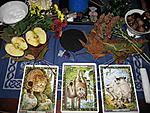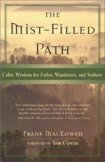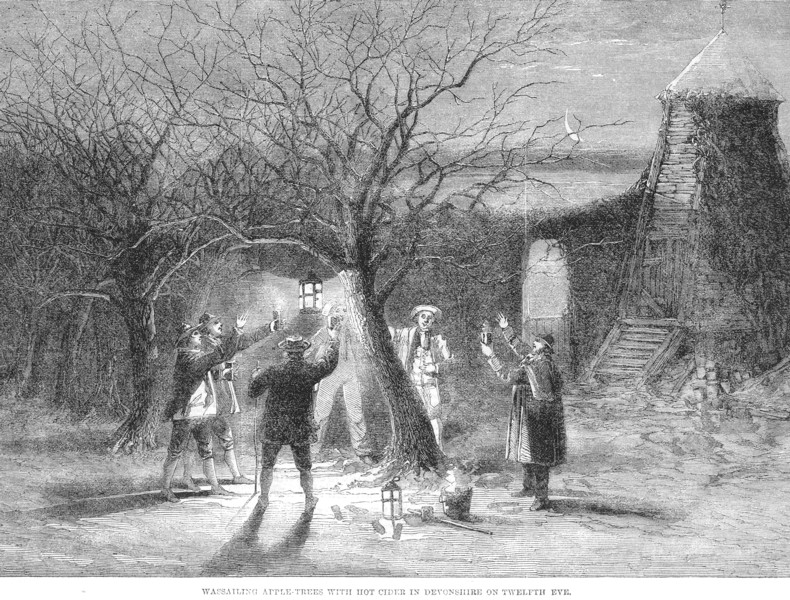
I would have to say that the
Druid Animal Oracle is my favorite choice of divination. Basically, it is a tarot that works with the sacred animals of the Druid tradition. The Druids were early psychologists whom noticed connections between the human psyche and animal behavior. By understanding and using these animals as guides, we can better understand ourselves.
I am drawn to the Druid beliefs, because they stem from a wanting and a need to return to nature. Let me clarify - my wanting and need. The Druids believe that once human kind lets go of its superiority complex, we can open ourselves to the experience of living with the community of Nature. Thus being a part of it, not separate. We can be welcomed back to the circle of nature, which we never really left except in our delusions. I think this is fundamental and unless we begin to try to return to the circle, we may destroy ourselves. Just an opinion, I’m not quoting doom and gloom. Please read on, you may discover something fascinating about a very old religion.
There are 5 animals represented on the Celtic totem. These five animals are thought to be the oldest in the world according to Welsh tradition. All five of these animals are represented in the story of Culwch and Olwen, this is the earliest of tales to speak of King Arthur. At a later date in a different section of the forum King Arthur would be a fun thread but for now I want to focus on the five ancient animals. The totem in order from Blackbird to Salmon is a journey one takes on his/her way to the Otherworld; each animal becoming more ancient till reaching the Salmon who is the oldest and represents the sacred pool.
Blackbird – (Gaelic name – Druid Dhubh)
The Gaelic name literally means the Black Druid. These birds sing elegantly at night and into the late hours. For Druids this signifies a transition from one reality to the next. The singing represents going from daylight and consciousness to the moon-time and unconsciousness – or the Otherworld. The blackbird’s song represents the beauty and potential of the gateway. The blackbird is the first of the totems because he stands at the gateway calling us with his song.
Stag – (Gaelic name – Damh)
The Stag is one of natures most beautiful creatures with his antlers being is biggest virtue. The antlers begin growing in early summer and are mature by rutting season in autumn. Around Imbolic on February 1st, he sheds his antlers in time for his young to be born. In Britain, the ritual of dressing like a stag is more than 9,500 years old. This ritual took place to capture the power, dignity and connection with the Otherworld. The Lord of the Animals was depicted as a man with a set of antlers. This figure is seen many times in Celtic lore including in the legends of Herne the Hunter (Merlin) and in legends of Cernunnos (the god of hunting and fertility). The stag is seen as a messenger from the Otherworld and is associated with the festival of Samhain on October 31st – November 2nd, when the veil is set aside from this world to the next so that we can commune with our ancestors. During this time he brings power and knowledge as well as carrying the King of the Faery and Merlin on his back.
Owl – (Gaelic name – Cailleach-oidhch)
The owl in Druid tradition represents objectivity and detachment and symbolizes esoteric wisdom and secrecy. The owl is sacred to the goddess in her crone-aspect. The Cailleach is the goddess of death and the owl’s call was often an omen of death. The owl called for the soul, caught it and took it away. Since an owl can foresee death, the owl as a totem suggests clairvoyance and astral travel. Taking the owl as an ally, allows one to pierce the boundaries of time and space. The owl reminds us of the ever-present reality of death, since it stands on the threshold of the Otherworld.
Eagle – (Gaelic name – Iolair)
Legends claims that high in the mountains of Snowdonia in Wales is the secret burial place of King Arthur. He is guarded by two eagles, whom will allow no one to pass. The two eagles are said to be two Druids who have shape-shifted and remain as guards of the tomb. In Gaelic, the eagle was sometimes referred to as Suil-na-Greine or Eye of the Sun. The kings of Ireland and Scotland wore plumes of eagle feathers, as well as Scottish clan chiefs who wore 3 eagle feathers representing the Druid symbol of Awen (the 3 bars of solar light). Irish legend states that the eagle rejuvenates in a sacred lake. Symbolically the eagle represents the intellect, the super-ego, the conscious self, and the heights. The lake represents the emotion, the unconscious, and the depths. Thus to find renewal, periodically we must shed our intellect and plunge into the subconscious.
Salmon - (Gaelic name – Bradan)
The salmon swims in the well of wisdom at the source of all life. The well is called Conla’s Well or the Well of Segais in Irish mythology. This well is the source of the River Boyne, the sacred river that runs through the Boyne Valley where the ancient Druid temples of Newgrange, Knowth and Dowth dwell. This sacred well has nine hazel trees growing around it, which nourish the salmon and give them their wisdom. It is described as a fountain with five streams flowing from it. These five streams represent the five senses. Knowledge is obtained through these five streams, but drinking from the well leads to inspiration. Druids believe that we must embrace the sensual world as well as infuse it with the spiritual world. Until we drink from the well – our lives are incomplete. The Druids believed that eating salmon, which in turn eat the magical nuts, would cause inspiration.
With all this being said, as I stated before the Oracle has become my choice of Tarot. Over the years, I have become close to the spirit that guides me with my deck. Interestingly enough it is the same spirit guide that has become a messenger totem for me as well - The Raven or Crow. Its the connection I have with The Raven that keeps me from even considering picking up another deck. Maybe in time, I will grow out of this connection or out of the Oracle. But for the time being...














